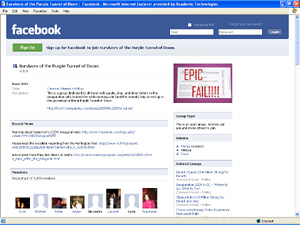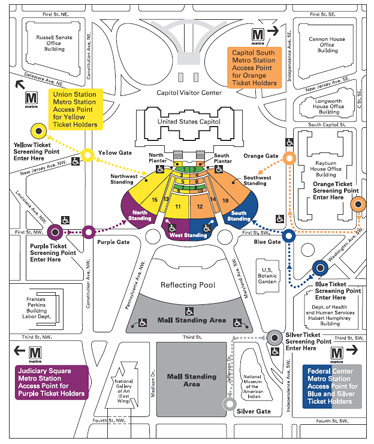March 23, 2009
Statement of Senator
Dianne Feinstein On the Law Enforcement Review of the 2009 Inauguration
Review
Washington, DC—The multi-agency law enforcement team, led by the
U.S. Secret Service, today released an executive summary of its review
of security and crowd management issues that developed during the 56th
Presidential Inauguration. In addition to the Secret Service, the
agencies that participated in the review included the U.S. Capitol
Police, the Washington Metropolitan Police Department and the U.S. Park
Police. The following is a comment by Senator Dianne Feinstein, who
served as chairman of the Joint Congressional Committee on Inaugural
Ceremonies:
“An enormous amount of preparation and planning went into this
historic event, and I am grateful to all those who worked so hard to
make the day a success. More than 1.8 million people attended the
inaugural ceremonies, the largest public gathering in the history of
Washington, DC, and there were no major arrests or injuries. But for
those with tickets who could not get into the swearing-in ceremonies,
or were turned away from the parade or one of the balls, it was a
tremendous disappointment and a cause for outrage. To address the
concerns raised by thousands of people who wrote to the Committee, I
asked Secret Service Director Mark Sullivan to commission this
comprehensive analysis.
While this review cannot change what happened, and may not satisfy
all of those who were shut out of the event, it does provide a good
assessment of both the successes and deficiencies of the planning for
2009. It also uses the lessons of 2009 to provide important and
thoughtful guidance for the next inaugural planners.
The law enforcement review showed that a number of factors led to
thousands of ticketed guests not being admitted to the Capitol grounds
in time to witness the inauguration. These factors included the
unprecedented crowds of non-ticketed guests trying to view the
inauguration and merging with people who had tickets; different
understandings of street closures between various law enforcement
agencies; inadequate crowd management tools to direct, sort and queue
the people seeking to get onto the Capitol grounds or gain access to
the National Mall; and a failure to properly monitor or respond to the
unexpected queuing of thousands of people in the northbound Third
Street tunnel tube.
Among the extensive recommendations made by the review team are for
the law enforcement agencies that have been solely responsible for
crowd management to adopt a more integrated approach to crowd issues,
including directly involving the Congressional and Presidential
Inaugural Committees in the planning process and turning over
responsibility for pre-screening and way-finding to these committees to
hire staff or recruit volunteers for this function.
The report also recommends that the authority be better centralized
within an executive steering committee established as part of the
National Special Security Event designation to help resolve conflicts
that might develop between the various law enforcement agencies
involved and ensure that all agencies are working together on a common
mission.
Some of the other key findings are provided below:
- The tickets printed in July did not have the most up-to-date
directions because changes were made to the silver ticket gate location
to accommodate revised parade and security plans, and a supplemental
map handed out with the tickets could have done a better job of
explaining the changes. The chief recommendation was to print the
tickets much later in the process—but an alternative might also be to
continue printing them over the summer, without a map, but include a
reference to a centralized web site and telephone hotline and ensure
that the map is printed at the latest possible date, and handed out
with the tickets. Much more extensive information on pathways to
the gates and queuing areas also should be made available on the
centralized web site utilized by all the agencies and committees
involved in the planning process.
- The review found that contrary to initial reports, no gate was
closed because the purple or blue areas and their overflow zones
had become too crowded. Nevertheless, a key recommendation is to
revise future plans to consider decreasing the number of standing room
guests to assure no problems in case of crowd surges or other
unexpected developments.
- The review concluded that adequate numbers of screeners and
magnetometers were used in the purple and blue areas, and the
16-foot-gates to get into the screening areas were wide enough for the
crowds. However, as a layman, I believe this should be examined
further in making preparations for the next inaugural.
- The Purple gate situation was aggravated by a nearby entrance to
the parade screening area, a nearby pedestrian exit from the southbound
tube of the Third Street tunnel through which crowds of non-ticketed
guests came, a proximity to Union Station and large crowds of
non-ticketed guests, and the compounding issues created by people
queuing in the northbound tube of the Third Street tunnel. There
were insufficient law enforcement resources at the scene, and no public
address system by which to communicate with the crowd at large.
- Also, the problems were worsened at Purple, Blue and Silver
because of insufficient resources and signage to keep the ticketed
guests and non-ticketed guests separated, and to form good queues for
arriving ticketed guests. The report makes a number of very good
recommendations for improving queuing, having better signs and
distributing them much more widely for both ticketed and non-ticketed
guests and for having public address systems at all the gates and
queuing areas. It also recommends transferring authority for
pre-screening and way-finding services from law enforcement and to
JCCIC for the swearing in and to PIC for the parade so they can hire
staff or volunteers to do this in place of law enforcement. I
agree that there is a major need for a much greater number of
pre-screeners and way-finders and other guides. I believe future
inaugural planners need to assess the best way to accomplish this and
whether to also utilize more National Guard or outside law enforcement
provided from other areas of the country.
- Regarding the Third Street Tunne—The northbound tube of the Third
Street tunnel had been reserved for emergency vehicles only—no
pedestrians—but according to the report, there were no barrels, signs
or other devices in place to block entrance and very early in the
morning, people started using it as a queue for the purple gate.
When a police team saw the queue, the report said they sought to
redirect people, but when that was not possible, they began telling
people to line up in the tunnel. However, it appears no police
report on this made its way to the multi-agency command post (MACC).
Later in the morning, when calls came into the MACC from people who
felt trapped in the tunnel, the information was misinterpreted and
officials were not aware of the extent of the problem. These are
very serious problems and need to remedied for the next
inaugural. The report recommends a number of changes to improve
joint planning and the use of tunnels and roadways, and ensure
high-level executive steering committee signoff of all such
plans. Another important recommendation was to create a much
better reporting system at the joint command center, along with a
future integration of social network tools such as Facebook, Twitter
and text messages from civilians to ensure more comprehensive
awareness of problems as they develop in real time.
Attached is a copy of the executive
summary
of the multi-agency law enforcement report. The Secret Service
has classified the full report as “law enforcement sensitive” and not
for public release.
###

